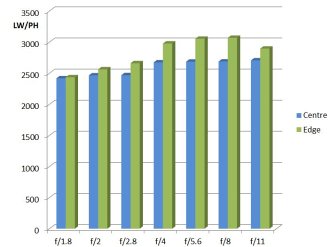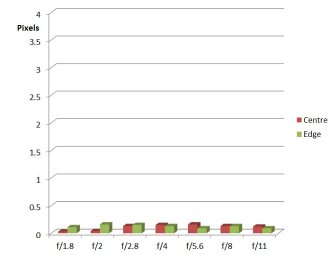Tamron SP 85mm f/1.8 Di VC USD Review
Tamron SP 85mm f/1.8 Di VC USD Performance
Sharpness is of a very high order, basically excellent across the whole image area and across the full aperture range, pushing towards outstanding at f/5.6 and f/8. The high level of corrections seem to have resulted in the edges of the frame outclassing the centre, although the figures are close and visually the sharpness is high and very even across the frame.
How to read our charts
The blue column represents readings from the centre of the picture frame at the various apertures and the green is from the edges.The scale on the left side is an indication of actual image resolution as LW/PH and is described in detail above. The taller the column, the better the lens performance.
For this review, the lens was tested on a Canon EOS 6D using Imatest.
Chromatic Aberration (CA), the splitting of light due to the lens not focusing all colours at the same point, is virtually absent. The CA figures are commendably low and consistently so across the aperture range.
How to read our charts
Chromatic aberration is the lens' inability to focus on the sensor or film all colours of visible light at the same point. Severe chromatic aberration gives a noticeable fringing or a halo effect around sharp edges within the picture. It can be cured in software.Apochromatic lenses have special lens elements (aspheric, extra-low dispersion etc) to minimise the problem, hence they usually cost more.
For this review, the lens was tested on a Canon EOS 6D using Imatest.
Distortion measures the amount of bending of straight lines and this too is very low indeed. It measures at +0.151% pincushion distortion, which is a negligible amount for general photography.
Flare is well under control and it was not possible to induce any in normal photography. The coatings and lens hood clearly do an excellent job.
The VC system seems to work best at slow shutter speeds, under 1/125sec, and gives us about 3-4 stops advantage. Remarkably slow shutter speeds can be used, even down to 1/15sec or so, which is remarkable for a short telephoto lens. Of course, this is no good if the subject is moving and in that case high shutter speeds will be needed to arrest that movement.
Images look deliciously crisp and the bokeh smooth and creamy. So out of focus areas take on a very smooth gradation, something that is very much sought after.
Value For Money
There is a wide choice of 85mm lenses available, perhaps unsurprisingly as this is the classic focal length for portraits. The Tamron SP 85mm f/1.8 Di VC USD is priced at £749.
At the high end of the options, the Zeiss Milvus 85mm f/1.4 costs £1379, equalled in cost by the Canon EF 85mm f/1.2 L II USM (£1499) and the Nikon 85mm f/2.8 D PC-E Micro-Nikkor (£1299). The Nikon is also a perspective control lens, adding yet another dimension of possibilities. Zeiss also offer the 85mm f/1.4 Planar (£989) and the Otus 85mm f/1.4 (£3299). The Zeiss lenses are manual focus only.
Alternative lenses from Nikon are the 85mm f/1.8 G AF-S (£399) and the 85mm f/1.4 G AF-S (£1199). Canon also has the EF 85mm f/1.8 at £237.
Sigma offer the 85mm f/1.4 EX DG HSM (£619). Manual focus options come from Samyang and Lomo. The Samyang 85mm f/1.4 IF MC costs £249 and the Lomo 85mm f/2.2 Petzval Art Lens in brass is £459, or the black version is £549.
For more options have a look at the Top 5 Best Tamron lenses.
Add your message
Please login here or if you've not registered, you can register here. Registering is safe, quick and free.
photodo Stats
428 MTF tests
74 in-depth photodo reviews
100+ users join each day
Help the lens community by reviewing or rating a lens today via our lens search
Latest Lens Reviews
- Chinon 28mm f/2.8 Vintage Lens Review
- Canon EF 70-200mm f/4L IS II USM Lens Review
- Samyang AF 85mm f/1.4 EF Review
- Sigma 70mm f/2.8 DG Macro Art Review
- Samyang AF 24mm f/2.8 FE Review
- Meike 50mm f/1.7 Review
- Tamron 70-210mm f/4 Di VC USD Review
- Lensbaby Burnside 35mm f/2.8 Review
- Asahi Super Takumar 50mm f/1.4 Review
- Asahi Super-Multi-Coated Takumar 135mm f/3.5 Review


